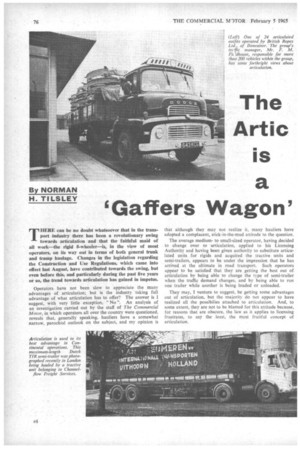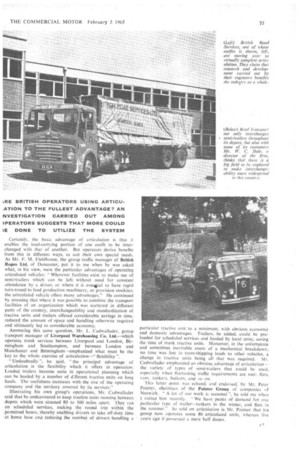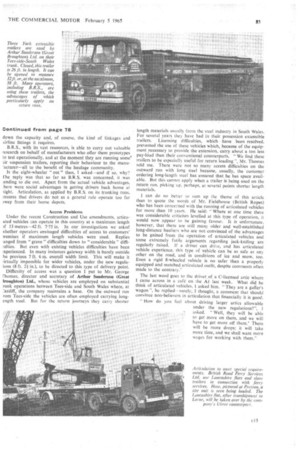The Artic Is a 'Gaffers Wagon'
Page 78

Page 79

Page 80

Page 85

If you've noticed an error in this article please click here to report it so we can fix it.
By NORMAN H. TILSLEY
iRE BRITISH OPERATORS USING ARTICU. ATiON TO THE FULLEST ADVANTAGE? AN NVESTIGATION CARRIED OUT AMONG OPERATORS SUGGESTS THAT MORE COULD IE DONE TO UTILIZE THE SYSTEM
THERE can be no doubt whatsoever that in the transPort industry there has been a revolutionary swing towards articulation and that the faithful maid of all work—the rigid 8-wheeler—is, in the view of most operators, on its way out in terms of both general trunk and tramp haulage. Changes in the legislation regarding the Construction and Use Regulations, which came into effect last August, have contributed towards the swing, but even before this, and particularly during the past five years or so, the trend towards articulation has gained in impetus.
Operators have not been slow to appreciate the many advantages of articulation; but is the industry taking full advantage of what articulation has to offer? The answer is I suggest, with very little exception, "No ". An analysis of an investigation carried out by the staff of The Commercial Motor, in which operators all over the country were questioned. reveals that, generally speaking, hauliers have a somewhat narrow, parochial outlook on the subject, and my opinion is
that although they may not realize it, many hauliers have adopted a complacent, stick-in-the-mud attitude to the question.
The average mediumto small-sized operator, having decided to change over to articulation, applied to his Licensing Authority and having been given authority to substitute articulated units for rigids and acquired the tractive units and semi-trailers, appears to be under the impression that he has arrived at the ultimate in road transport. Such operators appear to be satisfied that they are getting the best out of articulation by being able to change the type of semi-trailer when the traffic demand changes, and by being able to run one trailer while another is being loaded or unloaded.
They may, I venture to suggest, be getting some advantages out of articulation, but the majority do not appear to have realized all the possibilies attached to articulation. And, to some extent, they are not to be blamed for this attitude because, for reasons that are obscure, the law as it applies to licensing frustrates, to say the least, the most fruitful concept of articulation.
Certainly, the basic advantage of articulation is that it enables the load-carrying portion of one outfit to be interchanged with that of another. But operators derive benefits from this in different ways, to suit their own special needs. As Mr. F. M. Fieldhouse, the group traffic manager of British Ropes Ltd. of Doncaster, put it to me when he was asked what, in his view, were the particular advantages of operating articulated vehicles: "Wherever facilities exist to make use of semi-trailers which can be left without need for constant attendance by a driver, or where it is esse4tial to have rapid turn-round to feed production machinery, or provision stockists, the articulated veh:cle offers many advantages." He continued by stressing that where it was possible to combine the transport facilities of an organization which was scattered in different parts of the country, interchangeability and standardization of tractive units and trailers offered considerable savings in time, reduced the amount of space and handling otherwise required and ultimately led to considerable economy.
Answering this same question, Mr. L. Cadwallader, group transport manager of Liverpool Warehousing Co. Ltd.—which operates trunk services between Liverpool and London, Birmingham and Southampton, and between London and Manchester and Birmingham--emphasized what must be the key to the whole exercise of articulation—" flexibility ".
"Undoubtedly ", he said, "the principal advantage of articulation is the flexibility which it offers in operation. Loaded trailers become units• in operational planning which can be hauled by a number of d:fferent tractive units on long hauls. The usefulness increases with the size of the operating company and the territory covered by its 'services."
Illustrating his own group's operations, Mr. Cadwallader said that be endeavoured to keep tractive units running between • depots which were situated 80 to 100 miles apart. They ran on scheduled services-, making the round trip within the permitted hours,• thereby enabling drivers to take off duty time at home base and reducing the number of drivers handling a
particular tractive unit to a minimum, with obvious economic and domestic advantages. Trailers, he added, could be preloaded for scheduled services and hauled by local units, saving the time of trunk tractive Units. Moreover, in the unfortunate and sometimes inevitable event of a mechanical .breakdown, no time was lost in trans-shipping loads to other vehicles, a change in tractive units being all that was required. Mr. Cadwallader emphasized an obvious advantage of articulation— the variety of types of semi-trailers that could be used, especially when fluctuating traffic requirements are met: flats, vans, tankers, bulkers, and so on.
This latter point was echoed, and endorsed, by Mr. Peter Pointer, chairman of the Pointer Group of companies of Norwich. "A lot of our work is seasonal ", he told rue when I visited him recently. " We have peaks of demand for one particular type of trailer—tankers in the winter, and flats in the summer." So sold on articulation is Mr. Pointer that his group now _operates some 80 articulated units, whereas five years ago it possessed a mere half dozen.
13y standardizing on a particular type of coupling, most large operators have got interchangeability down to a fine art. Within groups this has been achieved, as instanced by the Smith of Maddiston Group. Trailers belonging to this group can one day be seen being hauled by a J. and A. Smith tractive unit and another day by a unit of one of the sister companies, H. L. Walker Ltd., of Thornaby.
Widen the Scope Leaving aside Continental operations—where the fullest advantage is taken of articulation—interchangeability between different hauliers in this country is practically non-existent; and this is one of the points where I suggest more could be done. Many of the hauliers interviewed agreed that there could be definite advantages to an extension of trailer interchangeability —beyond the limited ambit of depots within a company or group.
This particular aspect of articulation was put to Mr. W. C. Dale, a director of Reed Transport Ltd., of Maidstone, who was asked why there was so little interworking of trailers in the United Kingdom and could he see any possibility of a change in the future. He replied: "It is not true to say that we do not interchange with other companies. This is done on a limited scale where we are completely satisfied that
mechanically the trailers arc interchangeable ". The main argument against interchanging trailers, he continued, was that some coupling systems were not interchangeable, and also the fact that the general condition of trailers, he thought, "still leaves a lot to be desired ". But Mr. Dale felt that there was a very big field still to be explored in this country to make the interchange of trailers far more widespread than it was at the moment.
Another company which apparently is not shy of interchanging trailers with other operators is Davisons Transport Ltd.,, of Shildon, Co. Durham. A spokesman of this company, told me that they sometimes allowed hauliers to take over fully loaded trailers of theirs for delivery. The vehicles are usually away and out of their owners' control for three to four days and often are returned with a load for Davisons to deliver.
On this question, Mr. Cadwallader (Liverpool Warehousing) did not foresee very much extension of interworking "under existing conditions" in the United Kingdom. He felt that the larger operators who had adopted articulation had countrywide depots and could conveniently handle their own trailer fleets and provide traffic withoutinterworking; but, he added, as a rider: "The flexibility of articulation, together with interworking. may solve some of our future problems ".
When I put this question to Mr. Pointer, he was adamant that interworking, even with a good relationship (with' another haulier) just did not work. "We try ", he said, to keep the same driver wth his same vehicle and trailer ", and he expressed fears, which I have heard during the course of this investigation and which, I submit, goes to the very root of the problem—loss of control of the trailer while it is away with another haulier, plus a lack of confidence that his trailer will be handled with care and returned promptly.
Difficulties brought about by licensing were mentioned by several of the operators questioned, and Mr. Fieldhouse (British Ropes) stated that if it were possible to eliminate such restrictions, there would be considerably more scope for interchanging and irtterworking, particularly where a haulier—be he private or nationalized—could move with his tractor, semi-trailers which were owned by an industrial concern. Equally he felt, where two or three haulage companies shared the tonnage from a large producing concern, they would be able to assist each other considerably, particularly where the return of containers and/or
empties was part of the transport function. He pointed out the invidious position of hauliers "in one particular licensing area" in this connection and stated that until a loophole was found in the regulations or there was an alteration in them, it was not possible to forecast the likelihood of any change.
Mr. Fieldhouse, of course, was talking about the Northern traffic area. In particular he was thinking of the difficulties experienced by his succeSsor, Mr. Peter Jeffcock, in his previous appointment as general manager of Econofreight Transport Ltd., of Thornaby. The much-publicized articulation scheme in operation at the Cleveland Mill of Dorman Long (Steel) Ltd.— a scheme in which certain specified hauliers carry steel from Tees-side to 'specified destinations authorized in their licences— was severely hampered because the Licensing Authority concerned was applying the law rigidly and against the basic principles of articulation.
Hauliers in this scheme supply empty trailers to a marshalling area. For a nominal sum per ton full-time slave tractive units belonging to Econofreight Transport shunt them within the works for loading. The loaded trailers are then parked to await the arrival of the owner's matching tractive units, which draw _them to their destinations.
Leasing As An Answer?
The benefits to Dorman Long and their customers, brought about by such a scheme, are obvious, and this has been extended to include long-length trailers to cope with larger pieces of steel—which has in the past led to such protracted litigation in the traffic courts and before the Transport Tribunal.
Even this scheme does not really go far enough. The tractive units of a particular haulage concern pull only their own trailers. How much easier and more sensible would it be if they could haul any trailer in the scheme no matter to whom it belonged. Licensing—and particularly the way it is applied in the Northern Area where trailers belonging to an operator are specified in his licence not only by weight and type, but by serial number too—prevents this in most cases. Mr. leffcock—who was responsible for the planning of the scheme—told me that, human nature being what it is, with the best will in the world hauliers would never agree all the time. One way full interchangeability could work in a scheme such as Dorman Long's would be for a leasing company to be formed. Such a company would own the vehicles concerned in the scheme and would be responsible for maintenance and repairs, and ensure that an adequate number of trailers were available. Enough work would be involved to allow the employment of a full-time maintenance staff.
Coupling Limitations
British Road Servilkes Federation—the largest operator in the country—has recently placed large orders worth hundreds of thousands of pounds for new articulated units—tractive units and semi-trailers. They have made it known, so far as their future orders are concerned, that they will buy articulated vehicles rather than rigid vehicles—although, I gather, rigid vehicles will still be acquired for specific applications.
Although the trailer portions of the 7,000 articulated combinations operated by the general haulage company are fully interchangeable between depots, full interchangeability between the general haulage and the parcels companies is not possible because the former utilizes a fifth-wheel hitch, while the latter operate tractors equipped for automatic coupling.
Does the placing of orders by B.R.S. for hundreds of trailers with certain manufacturers mean that private hauliers are forced to purchase "off the peg' trailers designed basically to suit B.R.S. standards? This " moan " that is sometimes heard within the industry I put to an official. He thought that this was possibly so, but it could only be of advantage to operators. He said: "As the largest organization in the road haulage industry we do make a contribution to the development of that industry. Everyone has the benefit of our research on this and our engineers, of course, expend a great deal of time and effort before recommending what vehicles should be obtained." B.R.S. does not necessarily specify the actual construction of its trailers, nor the pattern. The companylays
down the capacity and, of course, the kind of linkagesand airline fittings it requires.
B.R.S., with its vast resources, is able to carry out valuable research on behalf of manufacturers who offer them prototypes to test operationally, and at the moment they are running some' lir suspension trailers, reporting their behaviour to the mann'acturer—all to the benefit of the haulage community.
Is the eight-wheeler " out " then. I asked—and if so, why? Me reply was that so far as B.R.S. was concerned, it was e nding to die out. Apart from the actual vehicle advantages, h ere were social advantages in getting drivers back home at light. Articulation, as applied by B.R.S. on its trunking runs, :nsures that drivers do not as a general rule operate too far sway from their home depots.
Access Problems Under the recent Construction and Use amendments, articuated vehicles can operate in this country at a maximum length A 13 metres-42 ft. 7-75 in. In our investigations we asked vhether operators envisaged difficulties of access to customers' remises if maximum length vehicles were used. Replies anged from "grave" difficulties down to "considerable" diffi:ulties. But even with existing vehicles difficulties have been :xperieneed. In many instances gateway width is barely outside he previous 7 ft. 6 in. overall width limit. This will make it rirtually impossible for wider vehicles, under the new regulaions (8 ft. 21 in.), to be directed to this type of delivery point. Difficulty of access was a question I put to Mr. George [Thomas, director and secretary of Arthur Sanderson (Great troughton) Ltd., whose vehicles are employed on substantial runk operations between Tees-side and South Wales where, at ardiff, the company maintains a base. On the outward run ram Tees-side the vehicles are often employed carrying. longength steel. But for the return journeys they carry shorter length materials usually from the steel industry in South Wales. For several years they have had in their possession extensible trailers. Licensing difficulties, which have been resolved, prevented the use of these vehicles which, because of the equipment necessary to provide the extension, carry about a ton less pay-load than their conventional counterparts. "We find these trailers to be especially useful for return loading ", Mr. Thomas told me. There were not so many access difficulties on the outward run with long steel because, usually, the customer ordering long-length steel has ensured that he has space available. But this cannot apply when a trailer is being used on the return run, picking up. perhaps, at several points shorter length materials.
I can do no better to sum up the theme of this article than to quote the words of Mr. Fieldhouse (British Ropes) who has been concerned with the running of articulated vehicles for more than 10 years, He said: " Where at one time there was considerable criticism levelled at this type of operation, it would now appear to be gaining favour. It is unfortunate, however, that there are still many older and well-established long-distance hauliers who are not convinced of the advantages to he gained from the operation of articulated vehicles and some extremely futile arguments regarding jack-knifing are regularly raised, if a driver can drive, and has articulated vehicle experience, this type of vehicle can be as safe as any other on the road, and in conditions of ice and snow, too. Even a rigid 8-wheeled vehicle is no safer than a properly equipped and matched articulated outfit, despite comments often made to the contrary."
The last word goes to the driver of a &licensed artic whom I came across in a cafe on the Al last week. What did he think of articulated vehicles, I asked him. They are a gaffer's wagon ", he replied—surely, I thought, a comment that should convince non-believers in articulation that financially it is good.
" How do you feel about driving larger artics allowable under the new regulations?", I asked. Well, they will be able to get more on them, and we will have to get more off them.' There will be more drops; it will take more time, and we shall want more wages for working with them."


















































































































































































